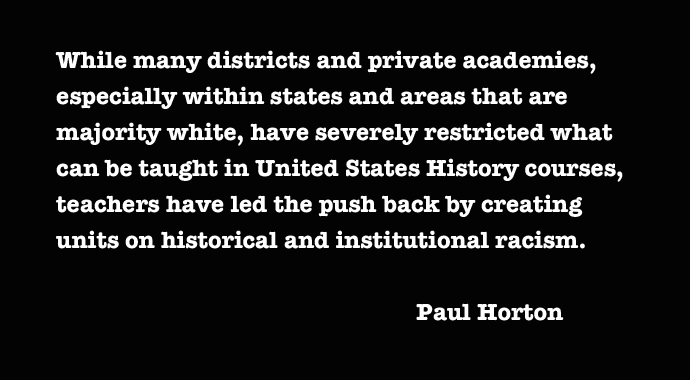By Paul Horton.
During the last year the Southern Poverty Law Center has reported an increase in hate crimes and hate groups. As political discourse in the United States in the late twentieth and early twenty-first centuries has become increasingly focused on identity politics, ethnic, cultural, and racial nationalisms have struggled to acquire opportunity and recognition within broader American publics. Reacting to this historical push from marginalized identity groups, an aggressive white nationalism has recently pushed back and reclaimed political power.
Although white nationalism has always been a dominant, if not the dominant ideology in American history, white nationalists in the twenty-first century often embrace policies of voter restrictions, immigration restriction, segregation, flight from public schools, and the defunding of any public programs at any level that are perceived to transfer public funds to minority groups.
Moreover, the current resurgence of white nationalism seems to be fueled by the prospect of a minority majority in the near future. Demographers have established that people of color will outnumber white Americans in about thirty years.
Another key element of the current white nationalism is a resurgence of the 1968 “Southern Strategy” of the “war on crime.” Minority and dissident behavior that actively and publically stand in opposition to white nationalism is increasingly viewed as criminal. More alarmingly, news reporting that directly challenges the hegemony of white nationalism is challenged as “fake news” and racism. Increasingly, attacks on vulnerable minority populations are not denounced, as a climate of fear and intimidation is encouraged by the inaction of many national leaders. The current chief political advisor to the President of the United States is strongly identified with white nationalism.
An essential task for educators today is to create a space within public schools and classrooms to connect current expressions of white nationalism with historical expressions of white nationalism within American history. A key contention of today’s white nationalists is that racism is something in the past; that racism against oppressed minorities is over and done with and that a level playing field of opportunity exists within the United States for all groups.
It is telling, moreover, that when the NEH National History Standards (1994) included a treatment of the Reconstruction Period Ku Klux Klan and stressed the repression of cultural minorities to counter the then dominant treatment of political and military history in textbooks, conservatives did everything they could to resist the broad adaption of the standards.
While many districts and private academies, especially within states and areas that are majority white, have severely restricted what can be taught in United States History courses, teachers have led the push back by creating units on historical and institutional racism.
When a well funded suburban school with a reputation for curricular experimentation like New Trier High School in Winnetka, Illinois, proposed a Civil Rights Day to discuss current and historical issues was planned, conservatives within the community objected. Some of them had connections with the local school board. As a result, the proposed Civil Rights Day became a subject of great controversy.
If such controversy is created in Winnetka, a north shore Chicago community with a reputation for teaching tolerance, it can happen anywhere.
Teachers, parents, administrators and students must lead an assertive push back against those who push an aggressive white nationalism — but will not tolerate being identified as racists. Unless we create broader and broader public spaces to connect the current American white nationalism with the dominant historical and institutional white nationalisms that have existed from the founding of the American Republic, we will lose, in effect, the “rights of Englishmen” that American patriots fought for and the civil rights that the Civil War and the 20th century rights revolutions created.
Paul Horton teaches history at the University of Chicago Laboratory Schools.






Leave a Reply